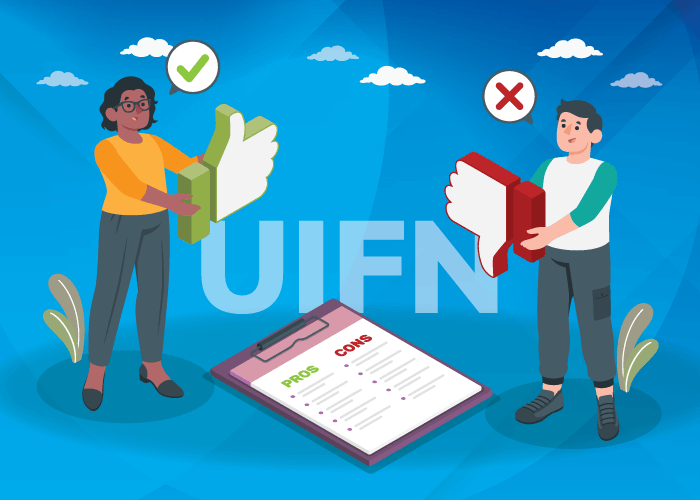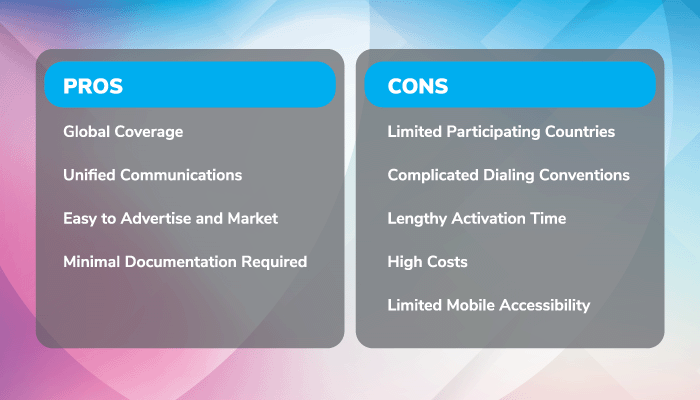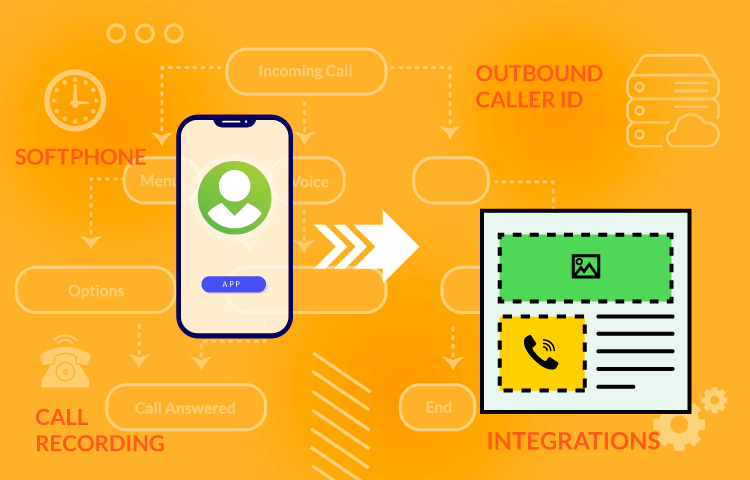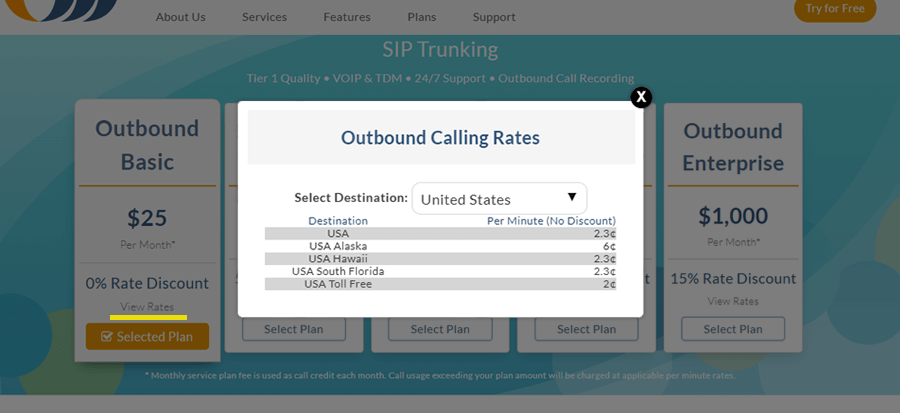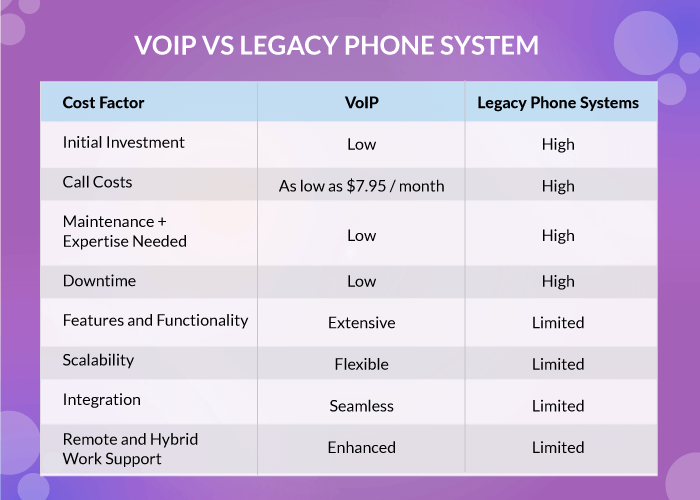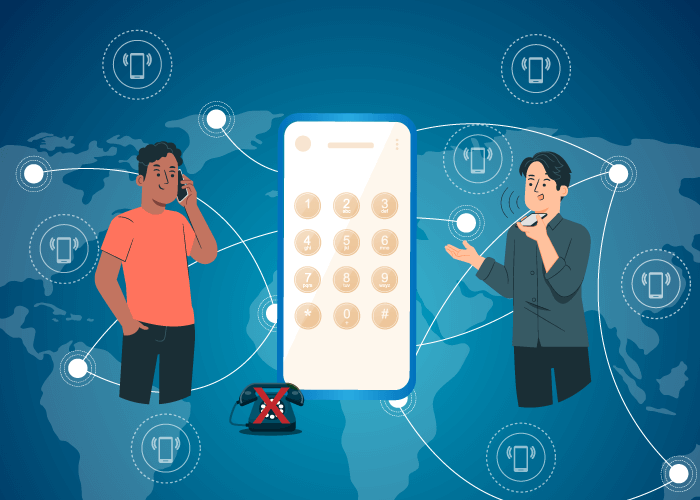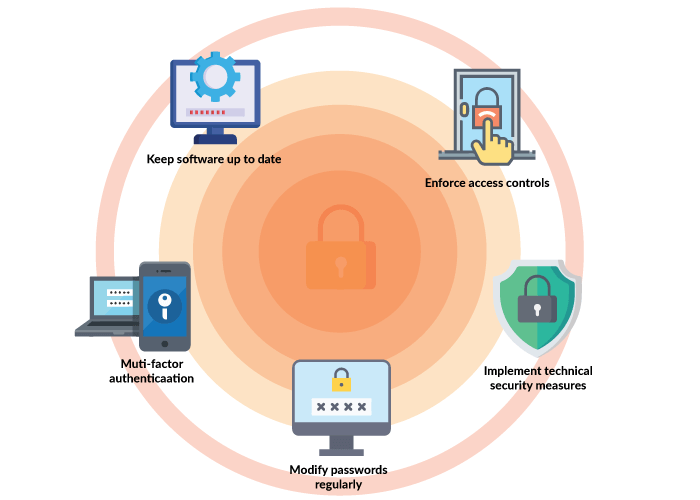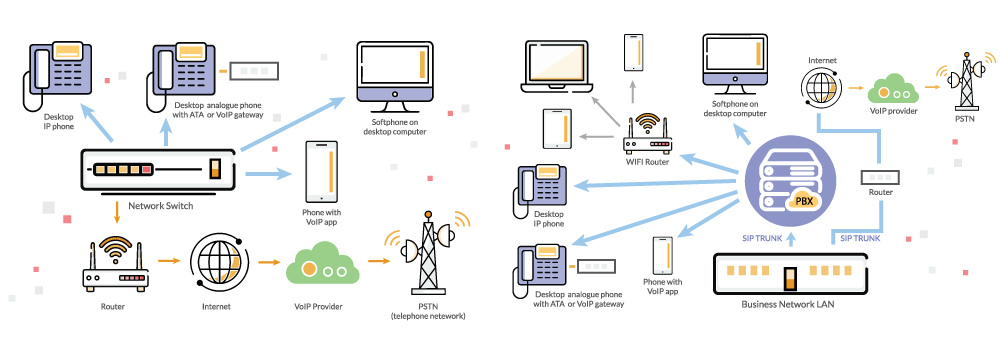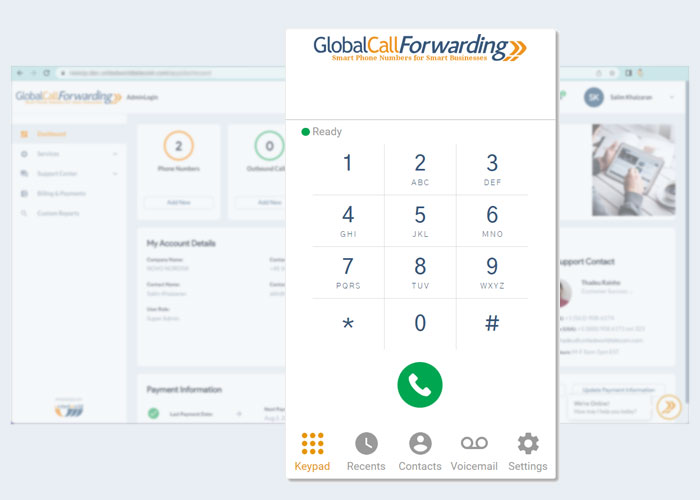Operational efficiency is like a compass that can guide your business towards adaptability and resilience, eventually boosting revenue. In a survey of 1,300 CEOs worldwide, a whopping 77% said that prioritizing operational efficiencies is their key approach to boosting revenue growth. This consensus among top leaders tells a clear story—efficiency is not just important; it’s a key part of the success formula.
In this operational efficiency guide, we’ll cover the following:
What Does it Mean to Improve Operations?
Enhancing operations involves creating a leaner, more responsive organizational structure. The bedrock of operational efficiency is well-designed, clear, and standardized processes. Such processes can eliminate unnecessary steps, reduce errors, save time, and ensure consistency in tasks, thereby, maximizing productivity.
The best example of operational efficiency for business is customer relationship management (CRM) software. The CRM is like a digital assistant that helps agents keep track of customer support interactions and manage information, allowing agents to respond quickly.
Say a customer calls in with a question. The CRM consolidates customer history, helping your agents to provide quick and personalized solutions. Now this CRM function not only saves time, but also improves the overall customer experience.
Importance of Operational Efficiency for Businesses
Improving operations isn’t just about cost savings; it’s about working more efficiently. For instance, when businesses smartly integrate digital technologies across their value chain and processes, they can see a 90% productivity increase, 50% energy efficiency, and 100% speed-to-market improvement, according to research by the World Economic Forum. This makes sure that your business can provide excellent service and adapt quickly to competition.
When you take time to improve business operations at various levels, you can:
- Streamline workflows,
- Optimize resources and reduce waste,
- Reduce inefficiencies and errors,
- Improve productivity and collaboration,
- Ensure faster delivery times,
- Offer reliable services,
- And maintain sustainable growth overall.
Which Areas to Consider to Improve Operations?
As you know, seamless operation is crucial for sustaining growth and staying competitive. From business communication infrastructure to customer service, each area plays a big role in how well an organization works. Focusing on these areas will help your teams work together better and make business processes smoother.
Let’s look at 9 operational areas where you can make improvements:
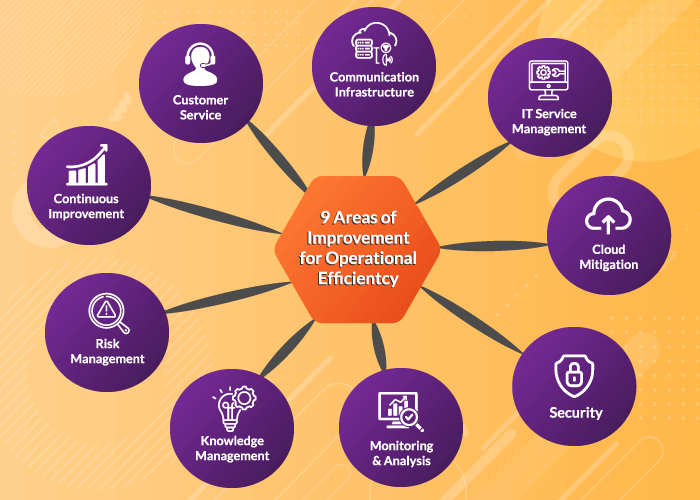
1. Communication Infrastructure
Upgrading communication infrastructure for operational efficiency requires bringing together all voice services in one central place. Imagine it as a single hub for all your business calls. This simplifies things—no more juggling between systems. By centralizing, you reduce the need to manage calls manually.
For example, you can effortlessly handle and track business calls from a single platform with centralized voice services. This means no fumbling between phones or missing crucial information. When a call comes in, you have everything you need in front of you. Discover the latest trends shaping the future of unified communications in 2024 in our article.
2. IT Service Management
Implementing IT service management (ITSM) frameworks like an information technology infrastructure library (ITIL) is like giving your IT operations a smart makeover. The ITIL framework standardizes processes, ensuring timely incident resolution, strategic capacity planning, smooth change management, and expedited problem resolution.
By implementing ITIL, you can create a robust and reliable IT infrastructure. This integration optimizes internal processes and fosters an adaptive business ecosystem.
3. Cloud Migration
Making this shift involves moving your business operations and data from traditional on-site servers to the cloud, which offers a secure and remote digital space. This cloud migration shift has many benefits: scalability, flexibility, and cost savings.
Depending on business needs, you can easily adjust digital resources, like storage and processing power. This adaptability helps avoid wasting resources during slow periods and accommodates growth during busy times.
Cloud services allow your team to access important data and applications from anywhere with an internet connection. This flexibility facilitates remote work, collaboration, and swift-decision making, contributing to overall efficiency.
Migration also reduces investment and maintenance costs. You can eliminate hefty investments in physical infrastructure. Cloud services operate on a pay-as-you-go model, meaning you only pay for what you use, reducing overall expenses.
4. Security
Prioritizing the protection of your IT systems can lead to a seamless workflow and safety of sensitive data. An essential aspect is setting up IT security policies and routinely updating and patching systems to fortify them against potential threats.
Conducting regular vulnerability assessments will help you identify and fix potential weaknesses, preventing security breaches. Implement best practices such as zero-trust security. In this security model, each user and device must authenticate and verify their identity before accessing resources. It is an additional layer of security that acknowledges that threats can come from both external and internal sources.
5. Monitoring and Analytics
Proactive monitoring helps identify issues before they impact users. This involves regular examination of different system aspects like its performance, security, and overall functionality. Incorporating best practices like continuous monitoring helps in actively staying ahead of potential issues.
A practical example of a tool in this realm is Application Performance Monitoring (APM) software. APM tools keep a close eye on how applications are performing, detecting any slowdowns or glitches. When an issue is identified, the software provides insights into the root cause, enabling quick resolution before users even notice a problem. This not only prevents disruptions but also contributes to a seamless and efficient workflow.
6. Knowledge Management
A knowledge base or documentation system can help store and share critical tech information, troubleshooting guides, and solutions. It serves as a centralized hub for important IT insights, which helps your agents find answers easily. You can also leverage such documentation—whether you use dynamic PDFs or the best AI for presentations for slides—to bring new employees and customers up to speed on your systems, making the onboarding process more efficient. This helps everyone work smarter and faster.
7. Risk Management
Whether you’re a large enterprise or small company, IT risk management is crucial. Develop and implement a risk management strategy to identify, assess, control, and mitigate IT-related risks. First, you need to identify possible risks to IT systems and how they might affect operations. Next, assess the impact and likelihood of these risks. And finally, take steps to reduce the impact or chance of issues occurring.
For instance, you can use tech tools like threat intelligence software. This software provides early warnings, allowing you to address security risks preemptively.
8. Continuous Improvement
This practice is a cornerstone for enhancing operational efficiency within a business. It involves encouraging your IT staff to regularly review and refine processes and adapt to changing business needs. They must methodically create and implement a strategy to recognize, evaluate, and mitigate potential IT-related risks, thereby ensuring the resilience of the digital infrastructure.
9. Customer Service
Efficiency in response times entails a prompt and streamlined interaction with customers. It is about ensuring that when a customer seeks assistance, whether through call, chat, or email, the response is swift and helpful, leading to reduced abandoned calls and interactions. AI and customer service go hand in hand—AI tools can assist in routing inquiries, suggesting solutions, and enabling 24/7 support. Quality support is the soul of customer service. Empower your agent with knowledge, tools, and resources to provide quick and personalized solutions.
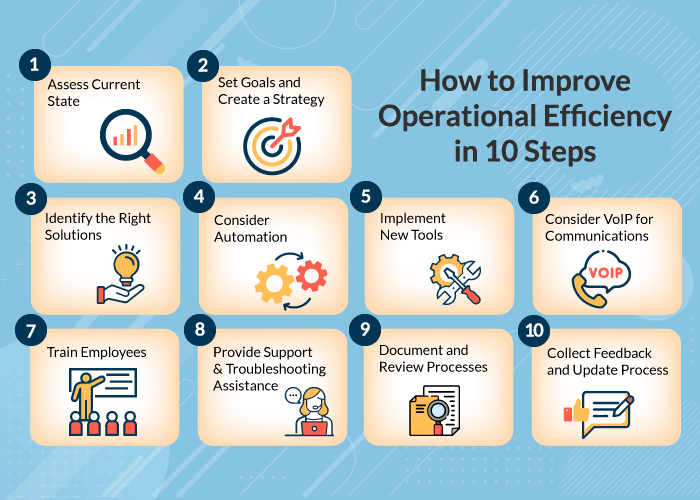
How to Improve Operational Efficiency in 10 Steps
To improve operations, you must prioritize streamlining processes to enhance productivity while minimizing resources. By assessing the current state, setting goals, and creating a strategy, organizations can identify areas for improvement. Then, select the right solutions, embrace automation, and implement new tools to significantly optimize workflows. Businesses that invest in these steps gain a competitive edge, ensuring sustainability and growth.
1. Assess Current State
A critical first step is to assess where your organization stands right now. This involves meticulously examining needs, identifying gaps, and understanding the essential ‘jobs to be done.’ This evaluation serves as the bedrock for crafting strategies to enhance operational efficiency.
Break down your examination into specific areas. Workflow processes, communication, security, storage, and technology infrastructure are some of the key areas you can look into. For instance, picture a store facing delays because its inventory system isn’t communicating well. By fixing how information is shared, like providing how the store tracks its products, they can make things smoother.
2. Set Goals and Create a Strategy
Clear goals and strategies provide a sense of direction, while a strategic plan outlines the steps to achieve those goals. For instance, introducing a knowledge management system and conducting targeted training sessions could be strategic initiatives aimed at achieving the goal of reducing average handling time.
Moreover, goals also serve as benchmarks for measuring progress and fostering accountability. The iterative nature of this process allows for continuous improvement, adjusting to changes, and maintaining long-term efficiency.
3. Identify the Right Solutions
It goes without saying that finding the right solutions is one of the most important keys to improving operations. It involves a strategic approach to understanding and addressing gaps and challenges, facilitating optimal use of resources. Research plays a crucial role in this process. It gives you valuable insights into industry best practices, latest technologies, and customer expectations.
For example, understanding the latest trends in customer communication channels may help you identify the right tools and strategy needed to fix bottlenecks in customer support workflows. This might mean using advanced software or automated systems to speed up response times.
4. Consider Automation
Automation is a game-changer. Take, for instance, the manual task of routing customer inquiries to the right department. Without an automation tool like an IVR system, this process could be time-consuming and prone to human errors. However, with automated ticketing systems, you can quickly direct incoming tickets to the right department or agent based on predefined criteria.
5. Implement New Tools
The shift to new tools is driven by the recognition that outdated systems can impede progress. You can not only boost efficiency but also future-proof operations. For example, modern communication tools like international call forwarding or community chat services facilitate real-time communication, document sharing, and thereby enable quick decision-making. By embracing the advantages of such tools, you can adapt to evolving demands, enhance collaboration, and streamline workflow.
6. Consider VoIP for Communications
Unlike legacy phones, VoIP phone systems allow seamless communication over the internet, reducing costs and increasing flexibility. Features like call forwarding, voicemail-to-email, and virtual numbers, VoIP streamlines communication, ensuring your team stays connected from anywhere.
More on how to use VoIP to improve operational efficiency below.
7. Train Employees
Your staff needs regular training on new tools, knowledge, and methods to stay adaptable and updated. Skilled staff can handle tasks competently and troubleshoot problems independently. For example, a retail store with trained staff processes customer transactions faster, preventing long queues. This, in turn, leads to better customer satisfaction. You may even consider running regular training sessions as refreshers to maintain quality.
8. Provide Support and Troubleshooting Assistance
Helping your agents with support and troubleshooting leads to swifter problem-solving and first contact resolutions. It empowers employees to handle challenges well and stay productive. Providing prompt assistance and a clear escalation matrix also prevents work disruption and contributes to a positive work environment.
9. Document and Review Processes
By documenting workflows, you can create an operations blueprint for others to use and resolve similar issues quickly. And regular reviews of the documented processes are crucial for two main reasons: continuous improvement and maintaining business continuity. Additionally, in times of employee turnover or unexpected events, others can step in smoothly because they have pre-existing guides.
10. Collect Feedback and Update Process
Gathering customer and employee input is a great way to identify and address specific pain points and hiccups. By incorporating this feedback into process updates, you can tailor operations to better meet essential needs. This step ensures processes remain agile and aligned with customer expectations.
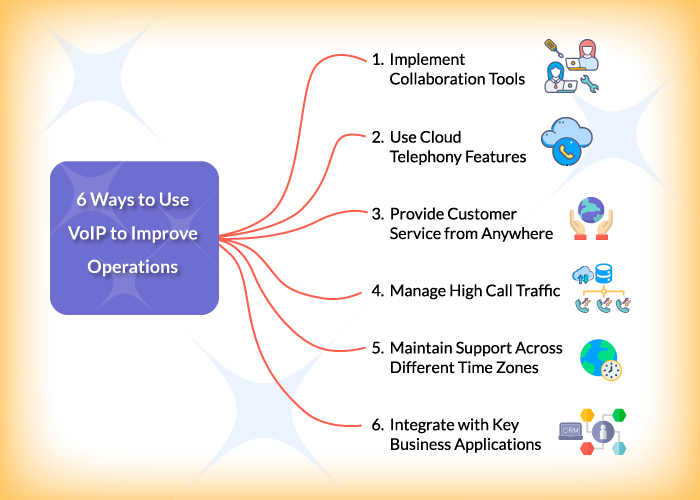
Using VoIP to Improve Business Communication Efficiency
So, how can your business use a VoIP service to make business communications streamlined and efficient?
Here are some practical applications of VoIP to improve operations:
1. Implement Collaboration Tools
VoIP supports audio calls, which offers your teams a more immediate way to interact, make decisions, and solve problems. An optimized VoIP network also offers a variety of channels to communicate. This way, your teams can choose the most suitable mode of communication for a given situation, optimizing efficiency.
For instance, a quick clarification can be addressed through chat, while a more complex issue could be discussed over a video call. This adaptability minimizes delays and overall responsiveness.
2. Use Cloud Telephony Features
You can leverage cloud telephony features like virtual numbers, call routing, and auto attendants to scale your business cost-efficiently. These cloud calling features help create a tailored communication infrastructure in line with your operational needs and business goals.
For example, the simultaneous ringing feature can enhance sales teams’ availability and responsiveness. Picture a scenario where a potential customer has urgent questions about your product or service and is considering making a purchase. With simultaneous ringing, multiple sales representatives receive the call simultaneously. The first available representative can answer the call promptly and address the prospect’s queries, securing a potential sale.
Check out the wide range of advanced calling features offered with every United World Telecom phone plan.
3. Provide Customer Service from Anywhere
Cloud communications ensures business continuity and productivity even during crises like power outages or pandemics. How is that possible? With the data and communication tools available online, your teams can collaborate, attend virtual meetings, and keep the work going.
Say in the event of a severe weather event that forces the closure of your contact center’s physical location, you can quickly and easily forward or route calls to alternative locations or remote agents. This ensures that customers can still reach a representative for assistance, regardless of the impact on your primary facility.
Similarly, time-based routing allows you to direct incoming calls to different locations or numbers based on the time of the day. For example, during business hours, calls could be routed to an in-house customer support team, while after-hours calls could be forwarded to a remote center.
This feature also helps you provide 24/7 support and remain accessible year-round from anywhere.
4. Manage High Call Traffic
VoIP call features, including smart routing and automated attendants, reduce wait times and manage incoming calls smoothly. Setting up failover forwarding to send calls to remote or backup teams during peak periods or emergencies can maintain service continuity. Similarly, you can use an automatic call distribution system to efficiently smartly and evenly distribute calls, avoiding overload on specific agents or service centers.
5. Maintain Support Across Different Time Zones
You can support customers in different time zones better. Using VoIP features, route and forward calls from different international locations to your global teams. In this manner, you can offer assistance even during off-hours. It’s like having a 24/7 support system without making everyone work at the same time.
6. Integrate with Key Business Applications
VoIP integrations serve as a vital strategy to improve operations. Specifically, CRM integrations with VoIP can cut down time spent on repetitive manual tasks and eliminates the need to toggle between apps.

Agents can receive caller details on their screen when a customer call is received or initiated. And they can easily place outbound calls directly from the CRM interface with a simple click. No need to grab the phone and manually dial the number!
How Can UWT Help?
As you know, operational efficiency is an ongoing commitment to improvement. Effective business communication influences how tasks are carried out, information is exchanged, and customer relationships are maintained.
Modern business communication tools can reduce errors and misunderstandings and facilitate better collaboration, thereby upgrading operations. United World Telecom offers many features to optimize and power your business communication.
 Network & Reliablity
Network & Reliablity Country Coverage
Country Coverage Testimonials
Testimonials Customer Stories
Customer Stories Local 2-Way Voice
Local 2-Way Voice Toll Free Numbers
Toll Free Numbers Local Phone Numbers
Local Phone Numbers Toll Free FlexDial
Toll Free FlexDial BYOC
BYOC Outbound Calling
Outbound Calling SIP Trunking
SIP Trunking Call Forwarding
Call Forwarding AI Call Insights
AI Call Insights Call Transcription
Call Transcription IVR Auto-Attendant
IVR Auto-Attendant Analytics & Reporting
Analytics & Reporting Call Recording
Call Recording Time-of-Day Routing
Time-of-Day Routing Voicemail
Voicemail Salesforce
Salesforce HubSpot
HubSpot Zoho
Zoho  MS Teams
MS Teams  Genesys PureCloud
Genesys PureCloud 3CX
3CX ZenDesk
ZenDesk  Intercom
Intercom Gorgias
Gorgias Onboarding
Onboarding Knowledge Base
Knowledge Base Blog
Blog
